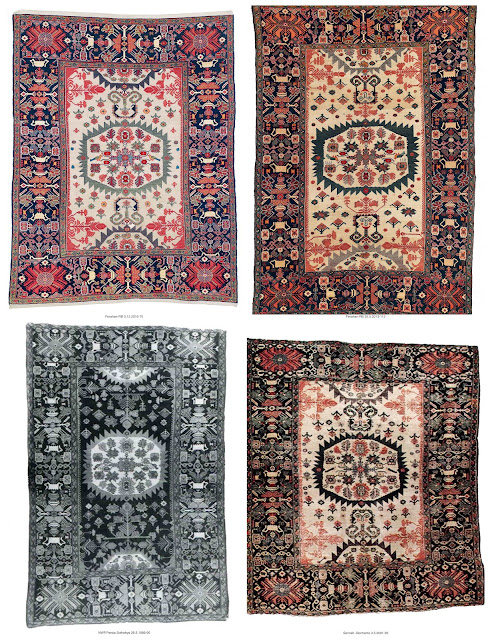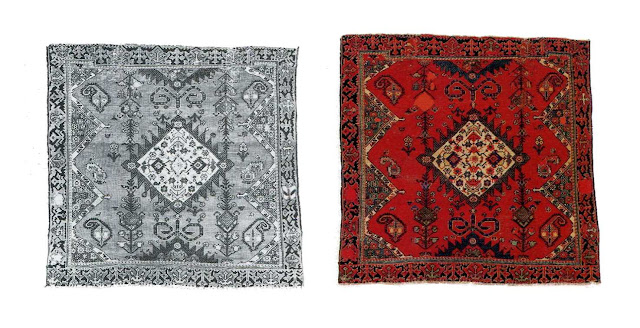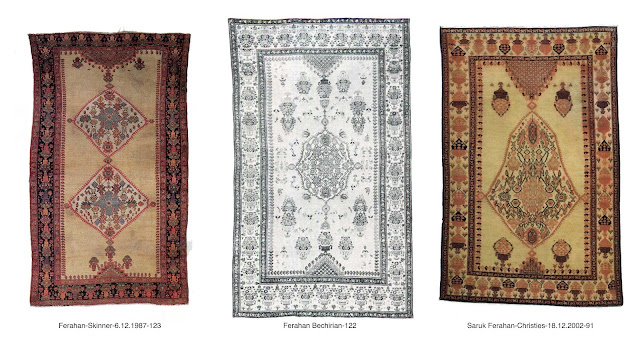 |
| Lorenzo Delleani,1880 |
Although classified as Ferahan,the following group has little in common with the standard type from the area, which is a mechanical repetition of the Herati design ad infintum.The Solar Panel rugs may have their roots in much older Turkish productions,which have left a trace in the distinctive aubergine colour used in the Dombak border.But perhaps the influence is simply input from Azeri dealers out of Tabriz.Some grand medallion carpets were produced in the area before a plague of dozar-size rugs won the day,but we know next to nothing about their makers,or the manufacturing environment.
 |
| 1 |
DEVICES USED IN FERAHAN SOLAR PANELS.
A central medallion in at least four different variants, invariably on a white ground.Earlier authors christened the design "Sunburn" when of course they actually meant "Sunburst",as in the classical Caucasian carpets.
 |
| 2 |
A pinched medallion with striated aureole frequently occurs,often accompanied by a complex border known as the "Dombakli".
That border is probably a refinement of one found on some Garden carpets, such as an example from the McMullan Collection
 |
| 3-McMullan |
 |
| 4-Pinched medallion |
Yet another variant features a squashed medallion
 |
| 5 |
 |
| 6-Dombakli border |
 |
| 7-A Persian Dombak drum |
 |
| 8-Pahari painting |
 |
| 9 |
 |
| 10 |
A large trophy-cup with bouquets,often used as a border device,or in the field,or both.The victory symbolism is also an allusion to the Dombak border.One group has the bouquets place sideways.The design,copied all over Iran, is known as the "Zil-i-Soltan" after a famous 19th century governor of Isfahan.
 |
| 11-the Zil-i-Soltan |
The carpets are usually in Dozar size with an all-cotton structure and Persian-knotted open to the left.Two large carpets are known,and the design was eventually adapted to fit into room-size carpets.
There are a number of silk rugs in the SP design,and the question poses itself:was this originally a design created for silk rugs?It is hard to believe that the immaculate silk rugs from Tabriz-Heriz(the terms are interchangeable) were developed from the simpler woolen examples.One constant amongst the silk rugs not observed in the woolen is the use of a Large-Medallion Ushak layout with one central and two cut-off medallions.There seem to be more silk rugs with the design in the NW Persian area than those in wool.
The earliest publication of such a rug is an example with the allover Dombakli field,in Lewis,Mystery of the Oriental Rug 1914(29)In 1953 Edwards published an example of the Zil-i-Soltan design which he attributed to Tafrish,in the Hamadan area.He remarks on" the ill-drawn circular medallion"-which reveals the extent of his connoisseurship.Presumably the example reproduced was of relative modern production.One should not apply too much of the Persian rug landscape of the mid-20th century to that of the 19th.It is clear that Edwards had scant knowledge of antique pieces.
Technical:
Azadi,Persische Teppiche 1971,Nr.63-Persian knotted to left;with some Turkish knotting.
Herrmann-Konya to Kokand 73: Persian knot open left. 75: Persian knot open left.
Herrmann SOT VII-52: Persian open to left.
Bausback 1981,page 81: Persian knot.
Bausback 1981,page 85-Persian knotted.
Bausback 1987/88-153:Persian knot.
Besim-Maktabi 1999-Persian knotted.
Financial:
1973 10 March Sothebys: $7,500; and 132-$6000.
1973 28.4 Edelmann:$17,600.
1976 2 April lefevre-17,000 GBP(Silk rug)
1979 10 October Sothebys 3800 GBP.
1908 27 November Sothebys Florene:7,150,000 Lira.
1983 Nagel 5 December: 8000
1983 28 April Edelmann: $17,600.
1985 17 April Sothebys $21,654.
1985 14 May Dörling DM 29,000.
1985 23 November Sothebys:$27,500;1997 10 April Sothebys $31,050;2004 2 April Sothebys $27,000.
1985 16 October Sothebys:$3,257.
1986 17 April Christies:$21,578.
1988 13 April Sothebys $ 45,254-a silk rug from Tabriz.
1990 20 January Sothebys $27,500-a silk rug from Tabriz.
1991 16 November Rippon Boswell 15,000 DM
1992 20.February: Anthony Thompson: $8065.
1992 10 December Sothebys $11,550; then again in 1998 15 April at Sothebys: $5,750.
1995 7 June Sothebys (Toms): $12,510 .
1997 Sothebys 10 April: $ 31,050.
1997 Skinner: $16,100;Sothebys 2015 1 October: unsold against an estimate of $15-20,000(Burns Collection).
1997 30 September Christies: unsold against $ 5-7000("Malayer") 2008 11 June Sothebys: $16,250.
1999 12 October Sothebys : 17,250 GBP;then in Herrman VI;$53,125;Sothebys NY 2009 16 December.A Sarouk version.
2003 1 April Sothebys $4500.
2003-2004-2009: Unsold at Christies.
2006 8 Spril Christies 1800 GBP.
2006 Christies 3360 GBP.
2006 9 October Christies:3120 GBP.
2007 19 May Rippon Boswell(saddlecover) 1200 euro.
2008 8 April Bonhams:2040 GBP.
2008 11 June Sothebys $ 16,250.
2009 5 December Rippon Boswell: 17.080 euro.
2012 24 November Rippon Boswell: 14,640 euro.
2013 5 May Rippon Boswell-unsold against an estimate of 12,000 euro; Christies 2013 8 October: unsold against an estimate of $7600-11,000.
2015 3 June Grogan:$2000; 2018 18 July Grogan:$1600.
2016 3 December Rippon-Boswell-7000 euro.
2018 23 April Sothebys 5000 GBP.
2019 28 April Skinner: $5,228.
Dombakli Border.
There are three types of this border.One is the complete design;a second has the design cut in half;and a third features the border as an allover field pattern.
A rug in Tehran can be seen as the Gold Standard of such things, with a piece sold at Rippon-Boswell in 2001 and 2011 closely following.These two are so well-made that one could a imagine a weaver,furloughed from a silk loom, might have banged it out in a short burst.Virtuoso workmen for whom this was all too easy.
 |
| 12-RB-Tehran |
Rugs with empty fields are more inviting;here the two overloaded fields keep us at bay.The weavers were trying to appeal to as wide a taste-spectrum as possible.To modern eyes the empty fields are preferable-the last hundred years were the most anti-decorative since the Neolithic.
 |
| 13 |
 |
| 14 |
.jpg) |
| 15 |
 |
| 16 |
 |
| 17 |
 |
| 18 |
 |
| 19 |
 |
| 20 |
 |
| 21 |
 |
| 22 |
 |
| 23 |
 |
| 24 |
- Here the red flowers impose laterally upon the field.Birdshakes' rug implies greater age through its noble condition.Self-deception anyone?The space above the Ram`s horn is filled with a flower,there where Our Lady's face should be.
 |
| 25 |
 |
| 26 |
 |
| 27 |
 |
| 28 |
 |
| 29 |
 |
| 30 |
 |
| 31 |
 |
| 32 |
 |
| 33 |
 |
| 34 |
 |
| 35 |
 |
| 36-Bausback 1981 |
 |
| 37 |
.jpg) |
| 38 |
 |
| 39 |
 |
| 40 |
 |
| 41 |
 |
| 42 |
 |
| 43 |
 |
| 44 |
 |
| 45 |
 |
| 46-Heriz-Tabriz |
 |
| 47 |
 |
| 48 |
%20(1).jpg) |
| 49 |